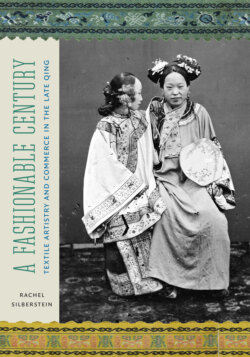Читать книгу A Fashionable Century - Rachel Silberstein - Страница 11
На сайте Литреса книга снята с продажи.
ОглавлениеTERMS, ABBREVIATIONS, AND CHRONOLOGY
Measurements
Fabrics were measured in pi (bolts), zhang (lengths or yards), chi (feet), and cun (inches):
1 pi = 4 zhang (11.11 m)
1 zhang = 10 chi (3.3 m)
1 chi = 10 cun (0.33 m)
1 cun = 3.55 cm
Shi (stone) is a unit of measurement equal to 10 dou (100 liters).
Currency
Qing China had a bimetallic currency of silver and copper:
Silver ingots (liang or tael, approximately 37.68 grams of silver) were used for large and wholesale transactions.
1 tael = 10 qian = 100 fen = 1,000 li
Copper coins or cash (qian wen) came in strings of 1,000 coins (chuan, diao) and were used for small retail transactions.
1 silver tael = 1,000 copper wen (official exchange rate; actual market rate fluctuated from 1:800 to 1:2000 throughout the Qing).
During the nineteenth century, foreign silver dollars (yang yuan) also circulated.
The Chinese yuan was introduced in 1889, when it was equivalent to 0.72 tael.
Museum Abbreviations
| AIC | Art Institute of Chicago |
| CMA | Cleveland Museum of Art |
| DAM | Denver Art Museum |
| Met | Metropolitan Museum of Art, New York |
| MFA | Museum of Fine Arts, Boston |
| MIA | Minneapolis Institute of Art |
| PEM | Peabody Essex Museum, Salem, Massachusetts |
| PMA | Philadelphia Museum of Art |
| RISD | Rhode Island School of Design, Providence |
| ROM | Royal Ontario Museum, Toronto |
| V&A | Victoria and Albert Museum, London |
Qing Dynasty Reign Periods
Shunzhi (1643–1661)
Kangxi (1661–1722)
Yongzheng (1723–1735)
Qianlong (1736–1795)
Jiaqing (1796–1820)
Daoguang (1820–1850)
Xianfeng (1850–1861)
Tongzhi (1861–1875)
Guangxu (1875–1908)
Xuantong (1908–1911)
